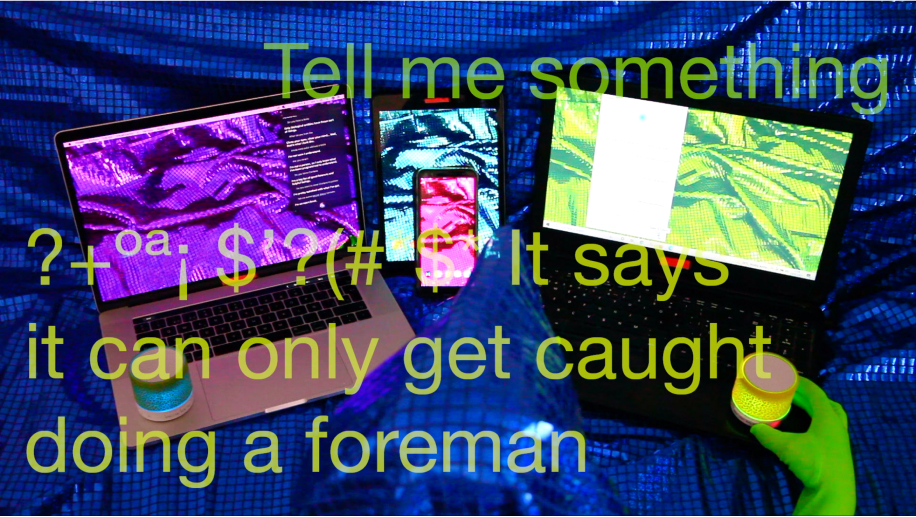by Pau Waelder & Willa Köerner
09 September 2021
Curator Pau Waelder on the never-ending instructions that govern our lives, humans’ innate quest for certainty, and how digital art collectors can best experience their NFTs.
This conversation happened on August 24, 2021 between Pau Waelder—the curator of Instructions Follow—and editor Willa Köerner.

What do you want me to say? by Lauren Lee McCarthy. Image courtesy of the artist and Feral File.
Can we start with a behind-the-scenes intro to the exhibition you curated for Feral File, Instructions Follow? What’s the concept, and how’d you land on it?
I wanted to create an exhibition around this idea that we are always following instructions—social, spatial, and technological—even when we don’t realize it. I’ve been doing curatorial projects for a long time now, and have been focused on issues of intimacy, control, surveillance, digital technologies, and how our data is shared. So those ideas are always present in my mind.
Then in March of 2021, when I was asked to curate a show for Feral File, the changes to our daily lives brought about by the pandemic were still very present. I was reminded of this one image from the year before, from a school in France where all the little kids had been placed in a big courtyard with a grid painted on the floor, with each child sitting in their own square. That seemed pretty awful. It reminded me of a video game tutorial—this idea of being told exactly where to sit or stand, all the time.
It also made me think, “This is the final realization of something that is already very present, where every space in our society is coded in a certain way. Depending on where we are and what we’re doing, we are almost always supposed to behave in a certain way.”
We also have layers of programming and software that inform so much of our behavior. Robin Kitchin and Martin Dodge have a book about this called “ Code/Space ,” in which they talk about how the objects and spaces of our lives work with software and code, and how these infrastructures of information lead to what they call “code/spaces.” For instance, when you go to an airport, all the procedures that you have to go through to get to your plane and to know when it’s taking off—all that is run by software. If that software stopped working, the airport would be in total chaos. So, we usually don’t see any of the software or code that keeps spaces like that running, even though they shape our behavior in a very real way.
Do you think technology has made us more passive in the way we take instructions? Sometimes I feel as though we’re all just waiting for the next email or the next notification to tell us what to pay attention to, and in that way it’s become harder for us to think for ourselves.
One of the things that has happened with the rise of the internet is that our access to information and news and everything else has expanded exponentially. Before the internet, there were fewer things to question, as our notion of the world was more limited, and more determined by our physical surroundings. But when you have around-the-clock access to endless information about what is happening everywhere all the time, that changes your perception. You can no longer live within a small-world kind of a reality. I think this expanded mindset has been good in many ways, but it’s also added a lot of uncertainty to our daily lives.
So, within that uncertainty, we are looking for things to grab onto—things that give us a sense of, “I know what I’m doing.” That quest for certainty has led us to rely on technologies that promise to solve our problems by keeping us busy, or by helping us sleep at night, or by helping us get fit, or by doing whatever it is that we think could give us more certainty in our lives. Following instructions makes things simpler, so we’re inclined to follow whatever the app or the software tells us, as a way to keep sane.

To talk a little bit more about some of the works in the show, are there shared characteristics you see between the artworks? How would you characterize the featured work overall?
A common feature of the works is that they are based on text or a narrative. Many of the works are quite conceptual as well, and ask the viewer to really dig into the content. For instance, Martin John Callanan’s work is a big text file composed of all the instructions he gave to Photoshop over 15 years. And Joana Moll’s work confronts you with all these slogans from tech companies that, taken together, show you how empty their words are.
What about affinities in terms of how the works are made?
Many of the works involved a lot of data collection in their creation. Lauren Lee McCarthy’s piece, for example, is based on a collection of the messages that people tell an AI version of her voice to say. Similarly, many of the works incorporate an ongoing process or a narrative, and require some time and engagement for a viewer to understand them.
What was the process like of working with the artists to translate their works into NFTs?
I’ve been following the NFT space since the beginning of the year, and I find it interesting how many people understand NFTs to have a specific kind of aesthetic. I feel like they’ve been kind of branded in a way that feels similar to how street art came to embody a certain aesthetic. A lot of NFTs also share the characteristic of being a single image that you can very quickly grasp, and that’s all there is to it.
To me, though, an NFT is just a way to register a digital artwork on the Blockchain—it’s not about the aesthetic at all. So, I just wanted the artists to be able to exhibit a digital artwork that could also be sold as an editioned NFT. Overall, I think that we have to go in that direction: Where a platform like Feral File can organize exhibitions in which artworks are accessible to a wide audience, while also guaranteeing proof of ownership for the people who do want to collect them, even though they are digital files that can be endlessly reproduced.

When people collect the works that are in your show, what do you hope they’ll do with them?
I hope they will watch them, and that they’ll take the time to experience them. Digital artworks shouldn’t just be stored on a hard drive somewhere where you’ll never look at them. One of the next steps for collectors is developing a system where you have a screen, or some other way of easily showing and displaying all the works that you have. It should be just like taking the file out and hanging it on the wall. It’s a very basic concept that takes us back to painting, where we can’t avoid this idea of artwork being something to have on display.
Personally, what I try to do is instead of going to Netflix to watch a TV show, I’ll take some time to open a work that I’ve collected and really experience it. All the works in this exhibition invite you to do that, because you won’t grasp them just by looking at them for half a second. You have to dedicate some time, at least a few minutes, to really feel into these works and experience them. So I hope that collectors will take the time to view the works, and to show them to friends and to think a bit about what the work is telling them.
With this NFT explosion happening, I know that many people are out there collecting works with the intention of reselling them later on. But I hope that these works will at least feed viewers’ curiosity, and that they’ll think a bit more about them than just, “Hey, I bought a cool work and I’m going to resell it to turn a profit.” These works are about much more than that, so I hope people will take the time to really consider what they’re all about.
https://feralfile.com/journal/close-up/code-is-all-around-us